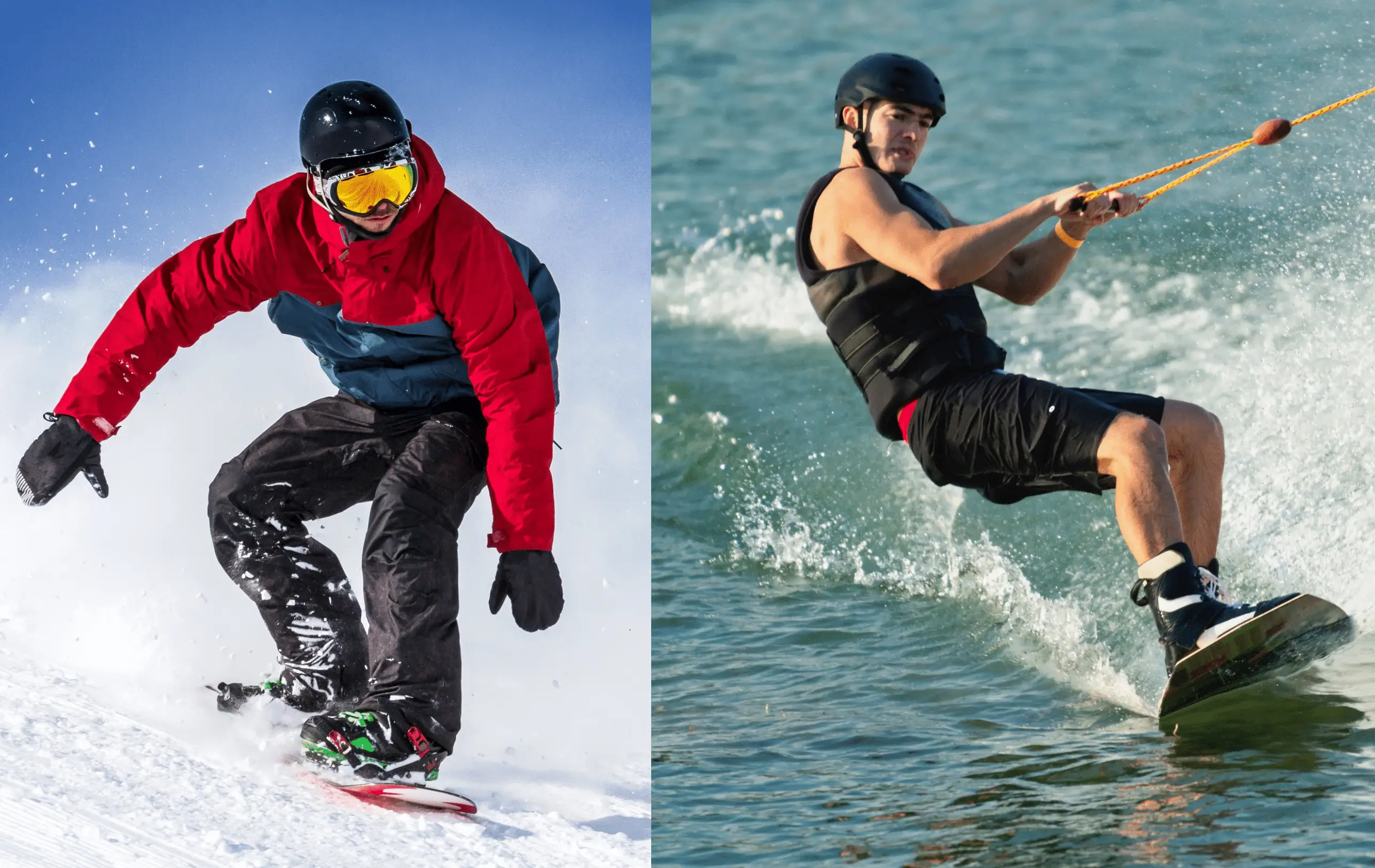On face value and account of the similar design of their boards, it may appear that wakeboarding and snowboarding are essentially the same sport, but on different terrains. However, there are many differences between the two sports. So which sport is more challenging?
Because snowboarding is a solitary sport, whereas wakeboarding involves third parties such as a boat and spotter towing the rider with a boat, the consensus is that it is harder to snowboard than wakeboard for beginners. Once learned, these skills are transferable but not identical.
Let’s compare and contrast the similarities and differences between snowboarding and wakeboarding in detail below to determine why snowboarding is considered the more challenging sport.
Why Is Snowboarding Harder Than Wakeboarding?
Although both sports are equally challenging to master, wakeboarding for beginners is much easier, as wakeboarding simply involves being able to stand up on your board and ride the wake with the assistance of a boat.
In comparison, getting up on a snowboard is done without any assistance and is only the foundation upon which you can snowboard, like the other techniques of controlling speed, turning, and safe stoppage are essential.
Consequently, while it is possible for most people to learn how to wakeboard after a few sessions over one or two days, learning to snowboard takes many sessions with skilled instruction over many days or weeks.
The Similarities Between Snowboarding And Wakeboarding
The obvious similarity between snowboarding and wakeboarding is that they are both extreme sports that require a person to stand up on a wide, flat board, moving at speed while maintaining balance.
Both sports require the rider to stand up and ride the board in a slightly crouched position, feet shoulder-width apart, and your weight event distributed to maintain balance, allow for a change of direction, and not overload the riders’ knees.
Both sports can trace their origin back to surfing, meaning the stance requirements of “regular” and “goofy” apply. The stance you use depends on which foot you put forward while on the board, with the left foot forward as regular and the right foot forward as goofy.
Note: to determine which stance is right for you, the general rule is to make your rear foot the dominant foot you would use for kicking a football (hence a regular stance involves the right foot as your back foot since most people are right-foot dominant.)
Finally, both sports require the rider’s feet to be securely on the board; thus, both sports require specialized boots and bindings to secure the rider’s feet to the board (although specific boards may have emergency release mechanisms.)
The Differences Between Snowboarding And Wakeboarding
The most obvious difference between snowboarding and wakeboarding is the different terrains and climates each sport is enjoyed. While snowboarding can only be enjoyed in freezing temperatures and mountainous regions (or artificial snow parks), wakeboarding can be enjoyed on various bodies of water.
Furthermore, while wakeboarding is predominantly a summer sport, you can wakeboard in cold climates provided you have the right equipment, such as a dry suit and booties.
Understandably, these different climates radically alter the way each sport is enjoyed. When wakeboarding, riders need the assistance of a powerful enough boat to pull them at the speeds required to maintain balance and ride the wake of the water.
Controlling A Snowboard Versus A Wakeboard
Wakeboarders are connected to the rear end of a boat via a tow rope while holding onto a tow handle. While riding the wake, wakeboarders communicate with a spotter on the boat who speaks to the driver about whether the wakeboarder wants to speed up, slow down, or stop.
Consequently, while a wakeboarder has the maneuverability to turn within the wake via their heels and toes, they are unable to escape the space afforded to them by the arc of a tow rope. Subsequently, the driver must steer the boat carefully and around obstacles.
Therefore, while wakeboarding does require lower body strength and balance, it also requires significant upper body strength and clear communication between the rider, spotter, and driver to wakeboard successfully and avoids injury.
In comparison, snowboarders have improved freedom of movement while snowboarding, whereby freezing conditions are ideal as it allows them to glide along with compact snow rather than digging through powder.
Because snowboarders are not reliant on third parties for speed or direction, they have to be able to turn with improved accuracy to avoid obstacles, judge their speed correctly, and stand up on their board and begin riding without the assistance of a tow rope.
Consequently, snowboarders have to be on the edge of their board, which requires an advanced level of balance and lower body strength (although upper body strength is not as crucial for snowboarding as it is for wakeboarding.)
Stopping A Snowboard Versus A Wakeboard
Because snowboarders have to control their movement without any assistance, they cannot rely on a third party to avoid obstacles or maintain their speed; therefore, learning to stop safely is essential.
Simply leaning backward into snow can prove dangerous if the snow is hard and/or your moment causes the rider to barrel out of control into obstacles! Therefore, safety equipment such as a helmet is essential for snowboarders.
In comparison, stopping during wakeboarding is simply a matter of signaling to the driver to slow down, or you can let the tow rope go in case you need to stop quickly. While either stop may result in a heavy fall in the water, there is limited momentum to carry you into distant obstacles.
However, if you stop while wakeboarding, it is essential to wear a life jacket and make yourself visible to the spotter so they can quickly retrieve you and signal to other boats that someone is in the water (usually via the use of a red or orange flag.)
Conclusion
In conclusion, while both these sports share numerous similarities, the difference in climate and terrain where these sports are enjoyed means that there are some notable differences.
These notable differences make snowboarding a more challenging sport to learn than wakeboarding.

